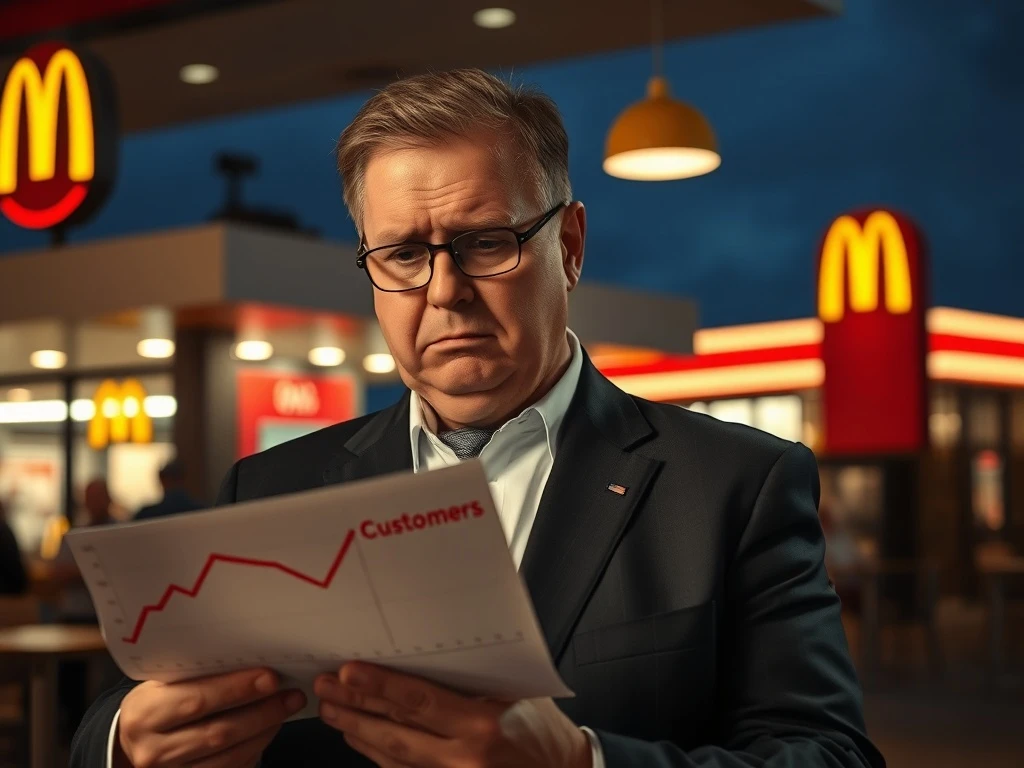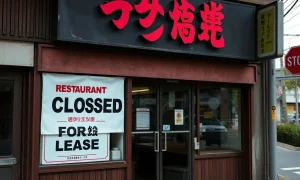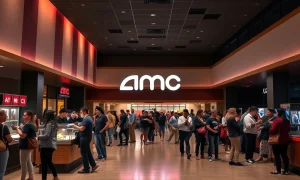The global fast-food giant McDonald’s faces a significant challenge. Its Chief Executive Officer, Chris Kempczinski, recently raised alarm bells. He specifically highlighted a worrying trend: increasing McDonald’s customer losses. This candid admission underscores the intense pressures facing the quick-service restaurant (QSR) sector. Business leaders and entrepreneurs are closely watching this development. Understanding these challenges provides crucial insights into market dynamics. Furthermore, it reveals how even industry titans must adapt to evolving consumer behaviors and economic shifts.
Unpacking McDonald’s Customer Losses: The CEO’s Dire Warning
Chris Kempczinski’s statements reveal a critical situation for McDonald’s. He specifically pointed to a noticeable decline in visits from lower-income consumers. This demographic group traditionally forms a significant portion of McDonald’s customer base. The CEO acknowledged that pricing strategies may have contributed to this shift. McDonald’s, like many businesses, has navigated rising operational costs. Consequently, it has adjusted menu prices.
However, these price increases have disproportionately affected budget-conscious diners. These customers now seek more affordable alternatives. This trend directly impacts overall customer traffic. The company’s sales growth, while still positive, primarily comes from higher prices. It does not reflect an increase in customer visits. Therefore, sustaining long-term growth becomes a pressing concern. This situation highlights the delicate balance between profitability and affordability. Furthermore, it emphasizes the importance of maintaining customer loyalty.
Kempczinski emphasized the need for McDonald’s to regain its value perception. This involves more than just competitive pricing. It also requires understanding the changing economic realities of its core customers. The company recognizes that retaining existing customers is often more cost-effective than acquiring new ones. Addressing McDonald’s customer losses at the lower-income segment is paramount. This strategy is vital for the company’s sustained market leadership.
Economic Headwinds and Shifting Consumer Habits Fueling McDonald’s Customer Losses
Several macroeconomic factors contribute to the observed McDonald’s customer losses. Persistent inflation has eroded household purchasing power. Consumers now face higher costs for groceries, housing, and fuel. Consequently, discretionary spending, including dining out, has decreased. Many families prioritize essential goods over restaurant meals. This economic squeeze directly impacts fast-food demand. Customers are becoming increasingly selective about where they spend their money. They seek maximum value for every dollar.
Beyond economic pressures, evolving consumer habits also play a role. There is a growing preference for healthier food options. Consumers are more aware of nutritional content. They often seek fresh ingredients and customizable meals. While McDonald’s has introduced healthier items, its core menu remains calorie-dense. Additionally, the rise of alternative dining options provides stiff competition. These include:
- Local diners offering unique experiences.
- Gourmet fast-casual restaurants providing higher-quality ingredients.
- Meal kit services for at-home cooking.
- Convenience stores expanding their prepared food sections.
These alternatives often appeal to specific dietary needs or preferences. They sometimes offer perceived better value or quality. Furthermore, the convenience of food delivery apps has altered dining patterns. Customers can now access a wider array of choices from their homes. This increased competition makes retaining customers more challenging. McDonald’s must adapt its offerings to meet these diverse demands. This includes both pricing and menu innovation.
McDonald’s Strategic Response to Stem Customer Losses
McDonald’s is actively implementing strategies to reverse the trend of McDonald’s customer losses. The company focuses on several key areas. Firstly, it is re-emphasizing its value proposition. This includes introducing new limited-time offers and promotions. These deals aim to attract price-sensitive consumers. For instance, some markets have seen the return of popular value bundles. Secondly, McDonald’s continues to invest heavily in its digital platforms. The McDonald’s app and MyMcDonald’s Rewards loyalty program are central to this effort. These platforms enhance convenience and offer personalized deals. They also encourage repeat visits through points and exclusive offers.
Moreover, the company is innovating its menu. This involves introducing new items that cater to diverse tastes. It also means refreshing classic favorites. For example, McDonald’s recently launched new McCrispy variations. These efforts aim to keep the menu exciting and relevant. Operational efficiency is another critical focus area. McDonald’s strives to improve order accuracy and speed of service. A positive customer experience is vital for retention. The company also uses data analytics extensively. This helps it understand customer preferences better. It also allows for more targeted marketing campaigns. By leveraging technology and strategic pricing, McDonald’s aims to rebuild customer trust and loyalty. These initiatives are crucial for regaining lost ground.
Competitive Landscape and the Battle for Fast Food Patronage
The fast-food industry is intensely competitive. McDonald’s operates within a crowded market. It faces strong rivals across various segments. Traditional competitors like Burger King and Wendy’s consistently launch aggressive campaigns. They often focus on value meals and new menu items. These chains directly vie for the same customer base. Additionally, newer fast-casual chains pose a significant threat. Brands like Chipotle and Panera Bread offer fresh, customizable options. They appeal to consumers seeking perceived healthier or higher-quality food. Local eateries and independent restaurants also contribute to the competitive pressure. They often provide unique dining experiences. They can also cater to specific community preferences.
The rise of ghost kitchens and virtual brands further complicates the landscape. These models operate without traditional storefronts. They focus solely on delivery. This increases the sheer volume of available food options. Furthermore, grocery stores and convenience stores have expanded their ready-to-eat offerings. These provide quick, affordable alternatives to restaurant meals. This diverse competitive environment forces McDonald’s to constantly innovate. It must differentiate its offerings. It also needs to reinforce its brand appeal. The battle for fast food patronage is ongoing. Companies must consistently adapt to stay relevant. They must also retain their market share. Understanding these dynamics is key to addressing McDonald’s customer losses.
Financial Implications of Persistent McDonald’s Customer Losses
Sustained McDonald’s customer losses can have significant financial repercussions. A decline in customer traffic directly impacts revenue. Fewer transactions mean less money flowing into the company. While price increases can offset some of this, they cannot fully compensate for reduced volume. McDonald’s operates on a high-volume business model. Its profitability heavily relies on the sheer number of daily transactions. A decrease in customer visits therefore erodes profit margins. This also affects the company’s ability to invest in future growth. Lower revenues can limit funds for marketing, technology upgrades, and new store development.
Moreover, investor confidence can waver. Analysts closely monitor customer traffic and sales trends. Negative reports on customer numbers can lead to stock price volatility. Shareholders may become concerned about the company’s long-term growth prospects. This can impact the company’s market valuation. Furthermore, a reduction in customer base can strain relationships with franchisees. Franchisees rely on consistent customer flow for their profitability. Reduced traffic impacts their bottom line. This can lead to operational challenges and potential disputes. Therefore, addressing customer losses is not just a strategic imperative. It is also a financial necessity for McDonald’s. Maintaining strong financial health requires a robust and growing customer base.
The Road Ahead: Navigating Future Challenges and Mitigating McDonald’s Customer Losses
McDonald’s faces a complex path forward. The company must continue to innovate while staying true to its core identity. Addressing McDonald’s customer losses requires a multi-faceted approach. Firstly, it must refine its value strategy. This means offering compelling deals that resonate with budget-conscious consumers. It also involves clearly communicating the value proposition. Secondly, digital transformation remains crucial. Enhancing the mobile app experience and expanding loyalty programs will drive engagement. These platforms provide valuable data for personalized marketing. Thirdly, menu evolution is essential. McDonald’s should explore new food items. It should also adapt existing ones to meet changing tastes. This includes healthier options and customizable choices.
Furthermore, operational excellence is non-negotiable. Faster service, improved order accuracy, and a clean environment enhance customer satisfaction. These elements build trust and encourage repeat visits. McDonald’s must also monitor global economic trends closely. It needs to adjust its strategies dynamically. This ensures resilience against future economic headwinds. The company’s long-term success hinges on its adaptability. It must also maintain its brand relevance. By focusing on value, digital innovation, menu variety, and operational efficiency, McDonald’s can navigate these challenges. It can also solidify its position as a leading global food service provider. The journey to regain lost customers is ongoing. However, McDonald’s possesses the resources and experience to succeed.
McDonald’s CEO Chris Kempczinski’s frank admission about McDonald’s customer losses serves as a stark reminder. Even market leaders face significant challenges. Economic pressures and evolving consumer preferences contribute to these shifts. McDonald’s is actively responding with strategic initiatives. These include enhancing value, expanding digital offerings, and innovating its menu. The fast-food landscape remains highly competitive. However, McDonald’s possesses the scale and brand recognition to adapt. Its ability to reconnect with its core customer base will define its future success. The company remains committed to overcoming these hurdles. It aims to reinforce its position in the global market.
Frequently Asked Questions (FAQs)
Q1: Why is McDonald’s experiencing customer losses?
McDonald’s is experiencing customer losses primarily due to two factors. Firstly, rising menu prices have alienated lower-income consumers. These individuals are now seeking more affordable dining options. Secondly, broader economic pressures like inflation have reduced discretionary spending. Consumers are simply eating out less often.
Q2: Which customer segment is McDonald’s losing the most?
McDonald’s CEO Chris Kempczinski specifically indicated that the company is losing visits from its lower-income customer segment. These are individuals who are most sensitive to price changes and economic fluctuations.
Q3: What strategies is McDonald’s implementing to regain customers?
McDonald’s is implementing several strategies. These include re-emphasizing value offerings and promotions. They are also investing heavily in digital platforms like their app and loyalty program. Furthermore, they are innovating their menu and improving operational efficiency to enhance the customer experience.
Q4: How do economic conditions impact McDonald’s customer losses?
Economic conditions significantly impact McDonald’s. High inflation and increased cost of living reduce consumers’ disposable income. This leads them to cut back on non-essential spending, including dining out at fast-food restaurants. They prioritize essential goods and seek greater value for their money.
Q5: Is McDonald’s facing competition from other fast-food chains?
Yes, McDonald’s faces intense competition. Traditional rivals like Burger King and Wendy’s offer competitive deals. Newer fast-casual chains and even grocery stores also provide alternative dining solutions. This diverse market landscape makes customer retention more challenging.
Q6: What are the long-term implications of these customer losses for McDonald’s?
Persistent customer losses can impact McDonald’s revenue and profit margins. It could also affect investor confidence and stock performance. Long-term success depends on the company’s ability to adapt. It must effectively re-engage its customer base and maintain its market leadership.
























